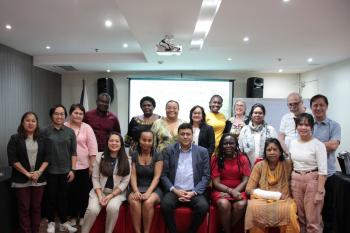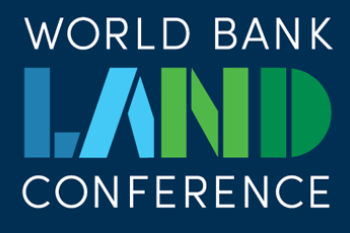
FIG Working Week 2019 highlights GLTN partners’ initiatives
The FIG Working Week 2019, held in Hanoi, Vietnam from 22nd to 26th April, provided another opportunity for land professionals to discuss on the challenges and emerging opportunities for securing land and property rights. During this year’s event, FIG, together with GLTN partners, jointly facilitated sessions and meetings which promoted GLTN’s vision of securing land rights for all. This would be achieved by strengthening partnerships in the development and implementation of inclusive, fit-for-purpose and gender-responsive land tools in both urban and rural contexts.
The joint sessions provided a platform through which land professionals discussed how various tools, approaches and initiatives could promote land governance at various levels - from community, sub-national, national, regional and global levels.
FIG, in collaboration with GLTN Secretariat, LX Korea, China Land Surveying and Planning Institute (CLSPI), FIG Asia Pacific Capacity Development Network and UN-GGIM Asia Pacific, facilitated two sessions on good practices on land administration and in strengthening partnerships in land governance in the Asia Pacific region. The sessions focused on sharing good practices, lessons learned and experiences in the region and ideas on how to reinvigorate partnership in the region building from strong cooperation amongst land professionals and other partner organizations working in land governance and land tenure in the region including on the GLTN’s Asia Pacific Regional Land Tenure Initiative.
 The special session on Fit-For-Purpose (FFP) Land Administration brought together various land experts to highlight experiences, challenges and opportunities of applying FFP approaches based on the respective projects or interventions that they have been involved in. Prof. Dr. Rudolf Staiger (FIG President), the opening speaker in the session, made a rallying call for land professionals to understand what the approach stands for, what it is not, appreciate the roles of the different stakeholders to support its implementation and finally, the need to develop critical success factors.
Together with FIG and the Young Surveyors Network (YSN), GLTN also facilitated a session on promoting the use and application of the Social Tenure Domain Model (STDM). During this session, participants were exposed to the conceptual and technical features of STDM, as well as given an overview of its application at the country level. The session also provided an opportunity for the new FIG YSN leadership to outline their vision and roadmap with a focus on volunteering for the future.
As one of the key champions in promoting the importance of monitoring the progress of achieving the Sustainable Development Goals (SDGs) within the Global Land Indicators Initiative (GLII), GLTN made key contributions to the first ever FIG Special Session on the SDGs. During this session, GLTN highlighted the work of GLII, the land indicators within the SDGs and the role of surveyors in monitoring the indicators particularly in data collection and reporting.
The special session on Fit-For-Purpose (FFP) Land Administration brought together various land experts to highlight experiences, challenges and opportunities of applying FFP approaches based on the respective projects or interventions that they have been involved in. Prof. Dr. Rudolf Staiger (FIG President), the opening speaker in the session, made a rallying call for land professionals to understand what the approach stands for, what it is not, appreciate the roles of the different stakeholders to support its implementation and finally, the need to develop critical success factors.
Together with FIG and the Young Surveyors Network (YSN), GLTN also facilitated a session on promoting the use and application of the Social Tenure Domain Model (STDM). During this session, participants were exposed to the conceptual and technical features of STDM, as well as given an overview of its application at the country level. The session also provided an opportunity for the new FIG YSN leadership to outline their vision and roadmap with a focus on volunteering for the future.
As one of the key champions in promoting the importance of monitoring the progress of achieving the Sustainable Development Goals (SDGs) within the Global Land Indicators Initiative (GLII), GLTN made key contributions to the first ever FIG Special Session on the SDGs. During this session, GLTN highlighted the work of GLII, the land indicators within the SDGs and the role of surveyors in monitoring the indicators particularly in data collection and reporting.
 GLTN also made several presentations that showcased the application of its tools and approaches in securing land and property rights in various countries, for different contexts, ranging from informal settlements, customary and post disaster contexts in developing countries in Africa and Asia Pacific regions. The presentations highlighted best practices and lessons learnt in the application of inclusive, gender responsive and fit-for-purpose tools and approaches, as well as the role of capacity development and knowledge transfer in promoting the sustainability of these interventions.
FIG, as the Professional Cluster Lead, also convened a Cluster meeting to identify areas where members of the professional cluster could support the GLTN Phase 3 programme. The discussion delved into specific areas such as support to network and country activities; resource mobilization; further development of tools on valuation of unregistered land and climate change; capacity development; and promoting SDGs monitoring particularly the indicator 1.4.2.
Overall, the event provided an opportunity for GLTN partners to engage and identify opportunities to contribute towards the realization of GLTN's vision and FIG mandates through an implementation approach that is catalytic and based on collaborative partnership.
GLTN also made several presentations that showcased the application of its tools and approaches in securing land and property rights in various countries, for different contexts, ranging from informal settlements, customary and post disaster contexts in developing countries in Africa and Asia Pacific regions. The presentations highlighted best practices and lessons learnt in the application of inclusive, gender responsive and fit-for-purpose tools and approaches, as well as the role of capacity development and knowledge transfer in promoting the sustainability of these interventions.
FIG, as the Professional Cluster Lead, also convened a Cluster meeting to identify areas where members of the professional cluster could support the GLTN Phase 3 programme. The discussion delved into specific areas such as support to network and country activities; resource mobilization; further development of tools on valuation of unregistered land and climate change; capacity development; and promoting SDGs monitoring particularly the indicator 1.4.2.
Overall, the event provided an opportunity for GLTN partners to engage and identify opportunities to contribute towards the realization of GLTN's vision and FIG mandates through an implementation approach that is catalytic and based on collaborative partnership.


